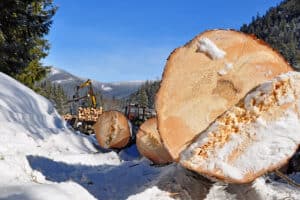The previous columns have discussed different ways that the volumes and monetary values in a timber cruise can be inflated. Timberland buyers need to protect themselves from seller-supplied information of this type. Earlier columns have suggested how a timberland buyer can become broadly familiar with the ways foresters estimate merchantable timber volume and value, and, secondly, how a buyer might find and evaluate a forester to represent his interests.
How should a timberland buyer use his own forester’s accurate cruise information with a seller who has provided inflated volumes and values?
The answer depends on how interested the buyer is in buying the seller’s property. A buyer can get huffy about the seller-supplied misinformation. This usually leads to a confrontation with the seller in which the words “liar” and “fraud” appear. When that occurs, negotiations end. It’s unlikely that a seller who has been called a liar will end up reaching terms with his accuser.
In some cases, the seller’s overstatement of timber volumes and values is so great that no timberland buyer will want to continue the pursuit of that property. Rather than belittle a seller, it’s usually better just to say “No thanks.” But the buyer should remember the name of the forester who prepared the bogus cruise.
Let’s consider the case of a timberland tract where the merchantable timber value has been inflated by a factor of two. The property’s asking price is $100,000 and the bogus timber value is $50,000. The buyer’s consultant forester puts the actual merchantable value at $25,000.
The buyer could write a direct — but polite — letter to the seller that explains where the two cruises differ and why the buyer’s appears to be more accurate (don’t use the word, truthful). A copy should be sent to the seller’s forester.
Individual states and professional forestry associations may have procedures for handling complaints of fraudulent work. If the inflation is clearly egregious and flagrant, I might file a complaint. The buyer should consult with his own forester on this sensitive matter.
The buyer, in this example, has one market “fact” in hand: the current merchantable value of a selective hardwood cut 16” DBH and larger in a marked, sealed-bid sale conducted by his consulting forester is likely to bring in $25,000 gross.
The buyer might suggest to the seller that since the seller’s cruise shows twice the value of the buyer’s cruise that they jointly fund a third cruise to establish value. A variation on this arrangement can provide that the losing party — that is, the party whose value is farthest from the third cruise’s value — pay the full cost of the third cruise. But the buyer in my opinion is likely to be advantaged in these circumstances by sticking with a straight 50-50 cost split. My guess is that most sellers don’t want to see the results of a third cruise and will decline the buyer’s suggestion.
The buyer might also suggest as one option that his price for the tract will be that number where the third cruise value represents, say, 60 percent of the gross sales price. If the third cruise estimates $30,000 in timber value, that would put the proposed sales price at $50,000. A buyer should develop a percentage formula of this type to reflect the value of the bare land, other property assets and his own financial circumstances and objectives.
The seller has priced the property with his own formula: asking price is twice the inflated cruise value and three times the actual cruise value of $25,000. The buyer can propose to the seller: I’ll pay twice the cruise value of $25,000, which is the accurate value of the merchantable timber. If the land is timberland, not second-home land, this formula is usually more than fair to the seller.
Formulas of this sort also gain negotiating traction when a buyer can find out what the merchantable value was at the time the seller bought the property in light of its then selling price. If the seller’s formula was 50 percent of sales price in merchantable timber, the buyer can argue that the same formula should be applied to the current sale when the former buyer is now the current seller.
To the extent possible, a buyer should try to move the discussion away from personalizing the conflicting dollar values — “My number is right; yours is baloney.” — to a timber value that both sides understand (even if the seller does not want to concede its accuracy).
The buyer should ignore the seller’s bogus cruise in negotiations, because its numbers are cooked and nothing is to be gained by debating them. The seller will lose credibility within the negotiations by protracted blustering about how his numbers are right and the buyer’s are wrong.
Even the most diplomatic buyer may not be able to work a deal with a seller who has only marginal interest in selling at a realistic price. Sellers who are able to wait for their price, will. Buyers are well-advised to move on to the next property when they find a seller stuck on an inflated price based on a bogus cruise.
This content may not be used or reproduced in any manner whatsoever, in part or in whole, without written permission of LANDTHINK. Use of this content without permission is a violation of federal copyright law. The articles, posts, comments, opinions and information provided by LANDTHINK are for informational and research purposes only and DOES NOT substitute or coincide with the advice of an attorney, accountant, real estate broker or any other licensed real estate professional. LANDTHINK strongly advises visitors and readers to seek their own professional guidance and advice related to buying, investing in or selling real estate.









Add Comment